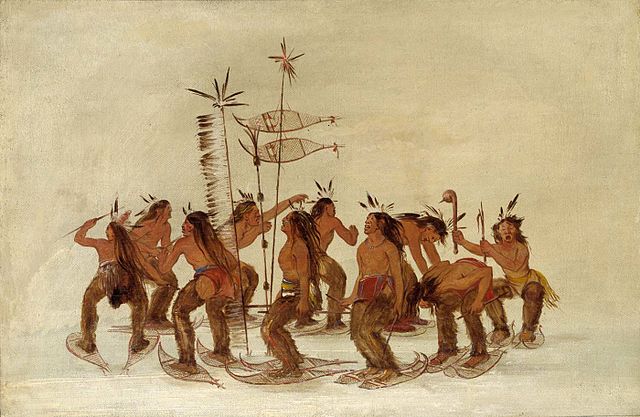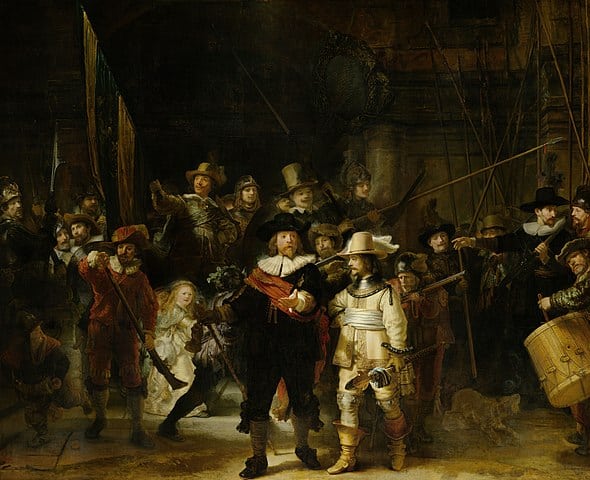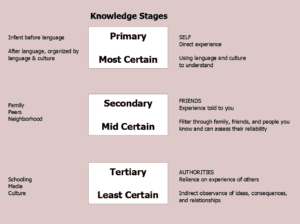When I hear the nature-nurture debate, it always falls into what genes you have or what experiences you have, but your experiences (your nurture) arrives via two distinct paths.
- That what happened to you personally
- That you have learned as culturally appropriate
Why is it necessary to consider them separately? Because direct experience and responses give rise to indisputable evidence, while responses driven by culture are less certain to match your deeper desires and are not personal reactions but guided behaviors.
Definition

The three figures depict three cultural behaviors. Figures 1 shows rhe snowshoe dance, a cultural, ritual response to seasonal change. Nightwatch by Rembrandt (Figure 2, below left) focuses on a political organization that developed in Dutch culture in the 1600s. The Christmas decorations in Paris’ Galerie Lafayette department store (Figure 3 below right) connects religious beliefs with physical display.


Merriam-Webster’s dictionary defines culture as
- the customary beliefs, social forms, and material traits of a racial, religious, or social group;
- also : the characteristic features of everyday existence (such as diversions or a way of life) shared by people in a place or time
Another definition has culture as “the way of life, especially the general customs and beliefs, of a particular group of people at a particular time.”
Social behaviors and social norms are found in human societies. Culture is a central concept in anthropology, encompassing the range of phenomena that are transmitted through social learning in human societies.
The reaction to an environmental situation by a set of people can occur across a set of behaviors. The behavior chosen is not fixed. A cultural norm directs the choice of behavior outside of the typical person’s choice.
Mental Construction focuses on the crucial effect of culture upon the behaviors we choose. Cultural behaviors are not responses to immediate demands, but are choices when immediate demands are distant from a day’s decisions. For instance, when safety is not of current concern, the style of home rises in importance.
Culture has various components: symbols, language, values, beliefs, norms, roles, social collectives, and material culture.
- Moral values. Just, fair, and good. punishments, sanctions, rewards
- Beliefs. Commonly believed as true, whether witnessed or not
- Roles define associates, wealth, power, responsibilities
Culture strongly influences many choices, such as the following:
- What style houses exists in your society?
- How do you celebrate birthdays?
- Would it ever cross you mind to marry a first cousin?
- Are people outside your group not trustworthy while people in your group are?
Culture’s Scope
The concept of material culture covers the physical expressions of culture, such as technology, architecture and art, whereas the immaterial aspects of culture such as principles of social organization (including practices of political organization and social institutions), mythology, philosophy, literature (both written and oral), and science comprise the intangible cultural heritage of a society.
Expressive forms like art, music, dance, ritual, religion
Physical expressions, such as architecture and art, and technology: tool usage, cooking, shelter, and clothing
Immaterial aspects, principles of social organization (including practices of political organization and social institutions), mythology, philosophy, literature (both written and oral) [language itself], and science comprise the intangible cultural heritage of a society.
Cultural expressions are a long distance from satiety, sex, and safety—the 3S Imperatives—which in earlier days required daily forced choices. Culture presents stylized choices to 3S Imperatives and their emotional derivatives (needs, desires, and fears), which first arose from memory and incomplete understanding of the relations between stimulus, reaction, and result.
Source of Norms
How is this possible? Once we, as a species, conquered the immediate demands of daily life, a wide latitude of behavioral actions in responding to the hitherto life-or-death choices were available for all to see.
Culture—where did it come from? It originates from the accumulation of actual direct experiences and behavior choices of our cultural ancestors. Culture are fossilized nurture decisions of the past.
Cultural universals are found in all human societies; these include expressive forms like art, music, dance, ritual, religion, and technologies like tool usage, cooking, shelter, and clothing.
Culture’s Role in One’s Worldview
We often follow culture norms rather than deciding for ourselves. Why? Cultural norms have worked in the past. They are part of the glue that allows us to live in groups, by making other people’s action predictable.
There are three types of knowledge we rely on to understand the world and to make our decisions.
Primary knowledge results from our direct reaction to our personal experience, especially pure and implacable in the first two years of life.
Secondary knowledge arrives initially by observing the reactions of our family to their particular successes, trials, and tribulations. Sometimes we get to see the actual situation and sometimes not, further diluting the accuracy of stimuli and response.
Tertiary, the least certain knowledge, is predominantly cultural. It is least The amount that is academic and scientific varies widely; therefore is not considered in this discussion, although it can be crucial to decision-making.
All knowledge, specifically cultural here, has two roles.
- Culture assists in organizing one’s experiences into meaningful units.
- Cultural knowledge imparts moral values to action
- It truncates events into units which that culture recognizes
- It allows us to assign motives to other’s actions.
- Culture constrains the behavioral choices we have available to respond to the situation, as we see it.
Beyond Culture
Culture strongly influences how we think and respond when the situation is not threatening to our more fundamental beliefs—our emotions (secondary knowledge) or raw 3S Imperatives (primary knowledge)—when we may override the tertiary (cultural) solution. This override requires much cognitive and moral energy, explaining why we don’t override often.
Additional Information
- Knowledge. Role of age
- Status Quo. Society and change
- Internal Worldview. Outside experience to inside understanding
Image Citations
Figure 1. Ojibwa snowshoe dance. George Catlin 1830s. Public Domain, wikimedia.
Figure 2. Nightwatch. Rembrandt, Public Domain, wikimedia.
Figure 3. Christmas in Paris. By Benh LIEU SONG – Own work, CC BY-SA 3.0, wikimedia.
